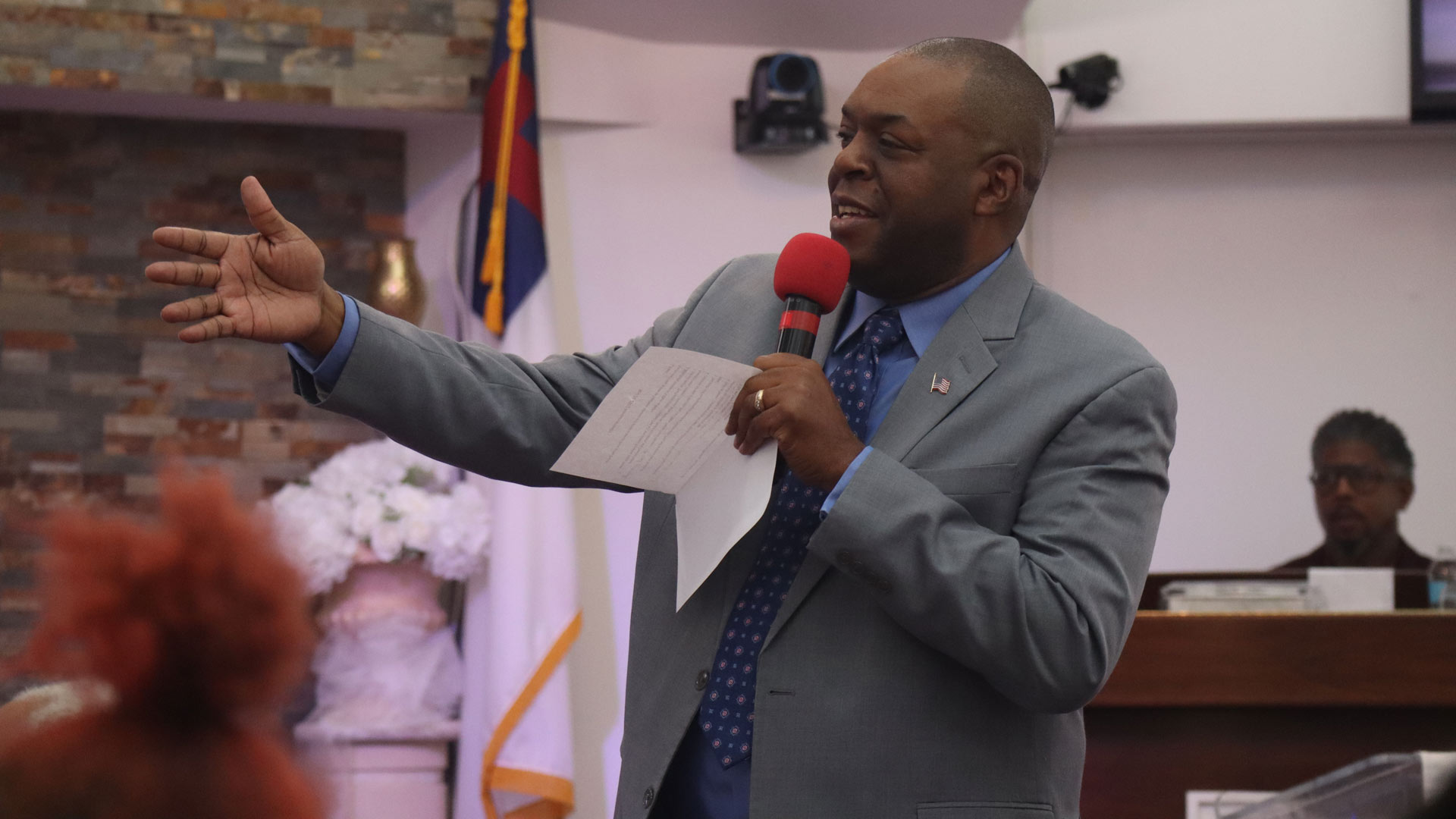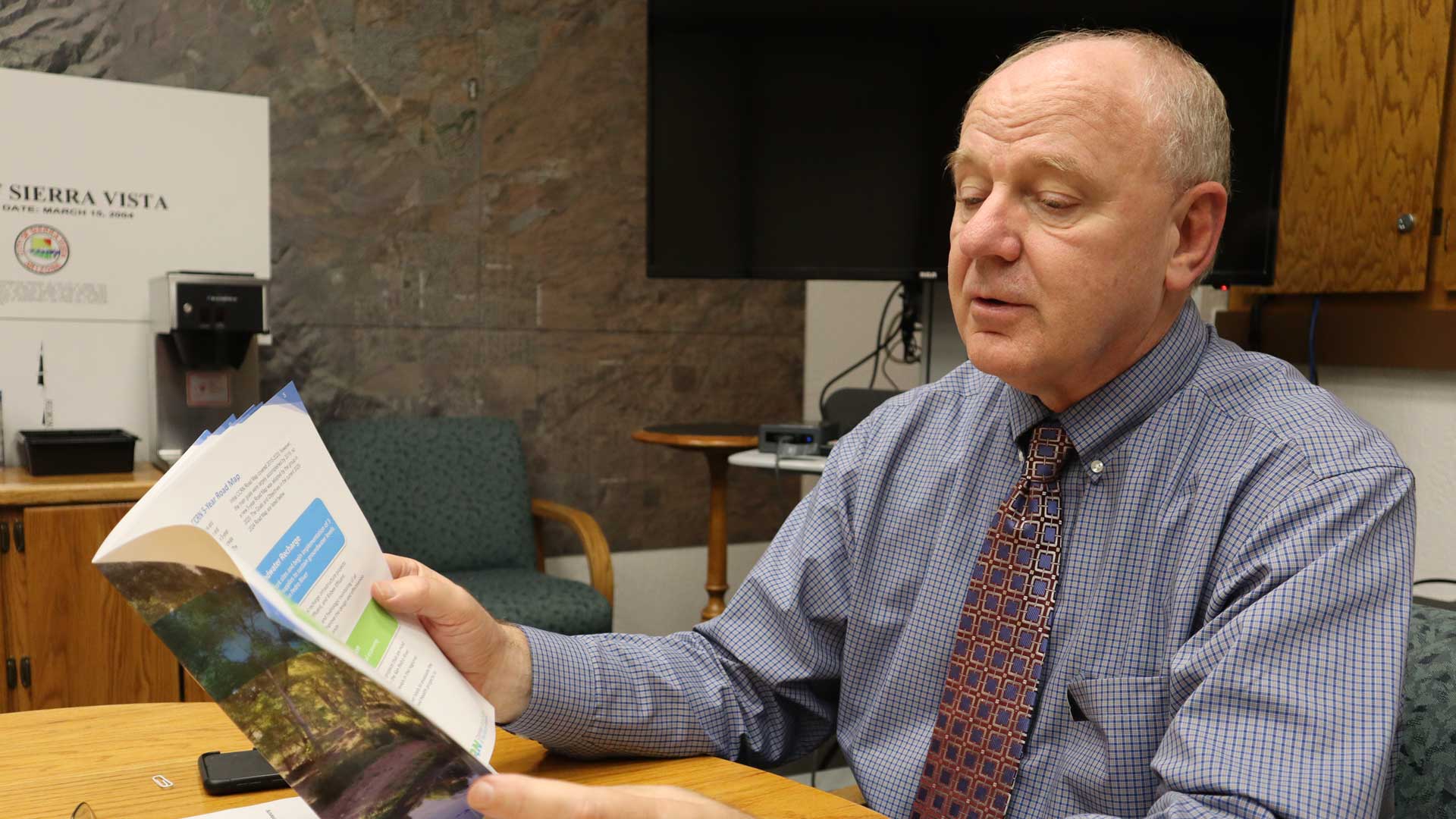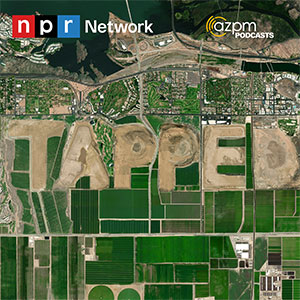Season 2 Episode 6: Water and Housing Redux

A housing development that would have made up the bulk of possible growth within the city limits of Sierra Vista appears to be dead. Castle and Cooke Arizona, the company who had shepherded the area through development and legal challenges for 20 years says it is not going forward with the Tribute subdivision. We hear reaction from various people around this news, and learn about why this may have happened.
Episode transcription
(fade in of sound of San Pedro River)
SH: A few weeks back, I took a hike down the San Pedro River as part of our Tapped episode on Housing Developments . . .
(field audio) The cicadas have come out, and it's a little more noisy than it was before.
SH: as this river has played a key role in the litigation surrounding two housing developments in Cochise County, Arizona.
(field audio) And it's also increasingly a lot more muddy down here, but lo and behold, there is water.
ZZ: And this vibrant ecosystem that surrounds the San Pedro has seen some pretty big changes from a legal standpoint, including one just after our episode that clears up an issue we mentioned. It now has some defined water rights.
There was also another big development in the story. Castle and Cooke Arizona, the company that planned to build a development in Sierra Vista that was about five miles from the river, announced that they are abandoning that project.
(theme music fades in)
SH: Since this was a considerable amount of news, we decided a short update was in order, so we can take a look at what this means for the San Pedro and Cochise County moving forward.
ZZ: This is Tapped, a podcast about water. I’m Zac Ziegler …
SH: And I’m Summer Hom. Now that part of a major water right case known as the Gila Adjudication has been resolved after more than 40-years, and the 19-hundred acre subdivision in Sierra Vista will no longer be developed, many questions remain. But the largest one of them is where do things go now?
(theme music fades out)
ZZ: So, Summer, every now and then, you get a story that, as soon as you publish your piece, something happens that could possibly negate so much of your work.
SH: [chuckles] Which lands us both back in the studio — or well, in Zac’s case, just home from a reporting trip to Page, AZ.
ZZ: Yeah, you'll hear more about that next week. But let’s get back on track here. So how about you bring us up to speed.
SH: About a day after our last episode aired, we got word that a Maricopa County judge had ruled on the part of the Gila Adjudication that determines — draws a line in the sand so to speak — on how much water the federal government is entitled to for the San Pedro River.
ZZ: But before we dive in too far into the weeds, let’s backtrack a bit for those just joining us. Why do these federal water rights matter when we talk about housing in Arizona?
SH: Well, the San Pedro River actually has been a main character surrounding the opera of litigation involving two major developers’ plans to create housing subdivisions in Cochise County. One of those developments, the Villages at Vigneto, is currently on hold because of a federal water permit that remains suspended. The other one however, was moving forward with their plans to add a couple thousand homes to the Sierra Vista area.
ZZ: Yes, that last one is the Tribute development, which Castle and Cooke Arizona planned to build almost 7,000 homes.
SH: And to make a very long story short, some local environmental advocates and the Bureau Of Land Management filed a lawsuit against Pueblo Del Sol Water Company — which is owned by Castle and Cooke Arizona — and Arizona Department of Water Resources, claiming that the increase in groundwater pumping that the Tribute development would require would adversely affect the flow of the San Pedro River.
Now that lawsuit was originally filed in 2013 and the case landed at the Arizona Supreme Court over one unanswered question: does the state have to take that unquantified federal water right into account before guaranteeing a 100-year supply of water?
ZZ: Now the Arizona Supreme Court ruled in favor of ADWR and Pueblo del Sol, ruling at the time that they did not have to consider a yet-to-be quantified federal water right. But now, the river has been given some water rights.
SH: Yes it has. Now those water rights are defined by monthly flow at four stream gauges that measure the surface water, and through water levels across nine wells within the San Pedro Riparian National Conservation Area — or otherwise known as the SPRNCA.
ZZ:Ah I see. Let’s start with the basics, Summer. This sent you back on the reporting trail, which led you to an interview with a noted water policy expert. How did the San Pedro initially become involved with a legal matter that has reference to the Gila River in its name?
SH: Well, to try to answer that question, amongst many others, I spoke with the director of the Kyl Center for Water Policy at Arizona State University, Sarah Porter, and she broke down how all of this began.
SP: There’s this proceeding called a general stream adjudication, and that’s what the Gila Adjudication is all about. It’s a huge legal proceeding to catalog all of the water rights in the watershed that covers about close to half of Arizona — about the bottom half of Arizona. So the Gila is the main river, but it has a number of tributaries, and one of those tributaries is the San Pedro River. What made the San Pedro in some ways a bigger deal is that there are several claims by the federal government for water from the San Pedro. In the late 1980s, the United States created an area called the San Pedro Riparian National Conservation Area.”
SH: Which Sarah says encompasses about 40 miles of the river across 57,000 acres.
SP: And so that’s one of the sources of the federal water rights claims. There’s also a U.S. military base down in that part of the state. And so they have a claim…
SH: That military base is Fort Huachuca, which is located near Sierra Vista. And Sarah says that this Gila Adjudication began in 1974. She says part of the reason for this adjudication was (a) the fact that water is a scarce and frequently sought out resource in Arizona and (b) there were lots of kinks in the administrative system at the time as to how we measured and defined the amount of water we actually had in Arizona. One big thing the state had to wrestle with is the relationship between groundwater and surface water.
ZZ: Right, surface water meaning water you can see: rivers, lakes, whatnot. And groundwater, as implied through the name, is water below that: aquifers and subsurface water basins, etc.
SH: That’s exactly right. Sarah says prior to an Arizona State Supreme Court ruling about 23 years ago, there wasn’t consensus about whether groundwater and surface water were related.
SP: It was in the adjudication that the question was raised ‘well, isn’t groundwater related to surface water?’ We’ve sort of had this fiction that they aren’t hydrologically connected. But they actually are. And the concern is that wells that are near a stream may be withdrawing water that would otherwise reach the stream either as surface flow or subsurface flow … In 2000, the Arizona Supreme Court recognized a connection, and said that if there is a well is in a zone that is popularly, commonly called a subflow zone, then the well owner needs to be a party in the adjudication for a determination of the extent to which that well is pumping out water that would otherwise be surface water or river water.
ZZ: And it’s this connection between groundwater and surface water that is the basis for measuring the water at the San Pedro using wells and stream gauges, right?
SH: Yes. And Sarah broke down what this ruling means and how it will protect the river moving forward. The main purpose for even having these water rights is to protect the desert ecosystem.
SP: When Congress created SPRNCA, Congress explicitly reserved sufficient water to fulfill the purposes of the SPRNCA. Much of it has to do with preserving this ecological area. It really is — we should be sure to say – an ecologically very significant area
SH: And part of that significance comes from the fact that the river serves a critical role to this ecosystem, which is home to 100 species birds, 250 species of migratory birds, more than 40 species of reptiles and amphibians and more than 80 species of mammals.
SP: It’s where the Sierra Madres, and kinda the tail of the Rockies, and two deserts come together. So, it is a very special place of great biodiversity.] And having a quantified water right as a result of the court’s ruling in the adjudication enables the Bureau of Land Management to actually enforce the right if needed so that ruling essentially says this much water should flow through the river — as you point out — different quantities at different times of year — it’s normal for rivers’ flows to change during the course of a year, and also as measured by wells within the SPRNCA. And if the — if any of those conditions doesn’t occur, the federal government, the Bureau of Land Management, now has the ability to go and try to stop other water users from either diverting surface water or from pumping subflow, because now they know the conditions of flow are conditions of the water table. So they have the information that’s critical to be able to enforce a water right.
ZZ: Now this ruling has some enforcement abilities for anyone whose water use could impede the flow of the San Pedro. And as we briefly touched on earlier in this episode, the Tribute development and its proximity to the San Pedro is what ultimately led the Bureau of Land Management and some local environmentalists to sue. I can’t help but think that this ruling might open the door for more litigation.
SH: Well, that probably won’t be the case now because as of earlier last week, news broke that Castle and Cooke Arizona, the developer for the Tribute subdivision, decided to not develop that 1,900 acres after all.
ZZ: Wow, and I remember you calling me after you confirmed that with Castle and Cooke that they are not going to develop the Tribute subdivision. Did they ever say why that decision was made?
SH: They have yet to release a public statement as to why. We have reached out to one of the heads of Castle and Cooke Arizona to see why that decision was made. As of this Wednesday when you and I are recording this podcast, we’ve yet to hear back from them about that reason why. But I was able to speak with Sierra Vista Mayor Clea McCaa and with City Manager Chuck Potucek and they told me how the news came to the city. Here’s what Sierra Vista Mayor Clea McCaa had to say.
CM: I had a met with Mr. Coffman …
SH: He’s referring to Rick Coffman, the Senior Vice President of Castle and Cooke Arizona.
CM: But when I met with him a week ago at his office, he didn’t seem too happy. And he disclosed that Castle and Cooke higher office said that they would not proceed with Tribute. I asked him ‘okay, does that mean that they won’t proceed with Tribute this year?’ And then he kinda just paused and looked and he’s like ‘they’re not going through with Tribute at all.’
 Sierra Vista Mayor-elect Clea McCaa
Sierra Vista Mayor-elect Clea McCaa
ZZ: That sounds rough for Castle and Cooke. Did the mayor know why that decision was made?
SH: He says that Coffman told him that Castle and Cooke decided to focus their investment on their developments in California and Hawaii instead of Sierra Vista.
CM: And that’s what he’s so discouraged about because he’s been working on this for the last 20 years with the water issues, going to court spending hundreds and thousands of dollars on court proceedings trying to develop this property. And when we had talked, he was like ‘I have been doing this for 20 years and it’s so disheartening that I come to when we’re about to turn some dirt and they tell me no they’re going to focus their efforts on Hawaii and California.’
ZZ: Yeah, considering the timeline of when Castle and Cooke started working on this development, it seems rather abrupt to pull the plug on the development when they were getting pretty close to finishing the planning process for the first neighborhood in that subdivision. But now, I’m wondering what the plans are for the land.
SH: I also touched base with the Sierra Vista City Manager Chuck Potucek, and he says there are some different options going forward.
CP: One would be to just suspend operations and wait until they feel such time it’s good to go, to proceed with developing it themselves. They could sell the whole parcel off to maybe to a large developer, who can then proceed, or they could choose to segment it off and sell it to various parties.
ZZ: Yeah, those seem like viable options. But were you able to speak with Rick Coffman about those plans?
SH: He did not have time for an interview, but I did run by him what the mayor and city manager told me, and he responded saying that “This was a business decision. And we do not have any immediate plans. We are evaluating all of our options.”
ZZ: Well, we’ll wait to see what they end up doing with the land. Big opportunities like this are rare for a city. Has Sierra Vista considered buying it so they don't have to worry about who controls so much of their future?
SH: Chuck said at this point, no, the city is not interested in purchasing the land.
CP: I really see no opportunity for the city in purchasing the property.
ZZ: Okay, but considering that this was going to add a significant number of homes to the area, what were the city manager and mayor’s thoughts on this considering the future of their city?
SH: Chuck says that there isn’t a dramatic effect from the canceling of this development from the city’s perspective so far.
 Sierra Vista City Manager and chair of the Cochise Conservation & Recharge Network Chuck Potucek discussing the conservation projects that will be funded through the Department of Defense’s Readiness and Environmental Protection Integration (REPI) program. July 2022
Sierra Vista City Manager and chair of the Cochise Conservation & Recharge Network Chuck Potucek discussing the conservation projects that will be funded through the Department of Defense’s Readiness and Environmental Protection Integration (REPI) program. July 2022
CP: Unless they come back or sell the parcels — that means the Tribute land will stay in its current state, which its been in ever since this process started. It’s fair to note as well that our projected growth rates are very small — less than one percent going forward by the state. So, I mean, it is possible that changes could occur on the fort that might require more housing in the future. Of course, we can’t predict when that’s going to happen. I imagine if something like that happened, which would increase the market in our area, that they would either proceed or somebody else would move forward and purchase the land.
SH: And Clea says that he is saddened to hear that the development won’t proceed. But he says there is a silver lining to be found here.
CM: I was very heartbroken. But, there is a bright side. There is a bright side. That bright side right now, I do not know. But we’re working with Castle and Cooke, you know, to market the property so that another developer can come in, and then, start developing.
ZZ: Now there’s one person who is related to this development that we haven’t touched base with yet, and that is Tricia Gerrodette, a local environmental advocate who was among the plaintiffs in this case.
SH: Yeah, I spoke with Tricia less than 24 hours after the Herald/Review newspaper broke the news about the development. She and I met at the San Pedro house and we talked about her reaction to the news.
(transition to field audio)
SH: What effect do you think not having this development have on the city’s future?
TG: Yeah, that’s. I’ve only had less than 24 hours to think about it. And I would hope that there will be a lot of talking about what it means. In one sense, the timing is potentially really good as the city is currently working to update their general plan. And I’m sure they’ve been a bit thrown for a loop. And I’m not sure what they think they’ll propose as a change to the plan. Um, anything that would try to go in there would — I think — run up against the same problem with regard to water availability that I believe made up the Castle and Cooke decision to cancel the project. So, I think there is limited opportunities for that land.
(transition back to studio audio)
ZZ: Yeah and just to clear Castle and Cooke has not said if water or the prior litigation was part of the reason behind their decision to pull out of Tribute.
One thing I remember hearing many people involved in this saying is that the worst-case scenario for future development around the San Pedro is what's called wildcat development, basically people building on a small scale, maybe just a home or two at a time. To my recollection, that type of development can skirt water assuredness rules. Did that come up at all with anyone you talked to, Summer?
SH: Well, Sarah Porter at the A-S-U Kyl Center for Water Policy says that loophole isn’t likely to be exploited for several reasons …
SP: Nobody really wants to buy 1,900 acres, and then sell the acres acre-by-acre. That isn’t the business of subdivision development. It’s not what Castle and Cooke does, or any big developer that I know of who would buy a 1,900-acre parcel. And most people don’t want to move into such a place like that, where you don’t know what kind of infrastructure you’ll have.
SH: She says that has happened, like the whole recent saga in the far northwest Phoenix area of the Rio Verde Foothills, where people were hauling water from Scottsdale but then the city cut off their access. But that style of developing is pretty rare.
SP: That's kind of an abject lesson where, that would warn people away from that kind of development happening. I don’t think there’s a real concern — a real legitimate concern — that one buyer would come in and sell off a parcel at a time with the idea that people would, you know, drill a lot of wells. But if they did, if that happened, theoretically, the Bureau could then enforce its water right against all 1,900 water users.
SH: She added that it would be harder for the Bureau of Land Management to enforce its water right because it’s harder to prove that individual water users will have an adverse effect on the river’s vitality rather than proving that a larger, industrial developer’s use would have a significant impact. And that could also affect the state's 100-year supply rule.
SP: There’s this kinda loophole in developments of fewer than six lots. That loophole — and mostly because of the Rio Verde saga — is something that there’s a lot more interest in closing. And who knows? But the legislature has the power to change the definition of subdivision essentially and make it so you can’t do that kind of lot-splitting style of development. But in reality, the business style of development to take a large tract of land, to plan and implement the infrastructure, you know, get the permits and do all the planning, and then, eventually implement after its all mapped out — the infrastructure including water, power, roads, sewers, all of that — I don’t know a developer, master plan subdivision developer, that would be interested in buying a piece of land and then selling it an acre at a time.
ZZ: Let's zoom back out. This adjudication ruling provides a legal backbone that could protect the river. Is this ruling final yet?
SH: Well, Sarah says the ruling has not been appealed yet. If it does get appealed, she says, it could go back into litigation.
SP: Now that the Bureau has a quantified water right, it has the ability to enforce that right if it believes that a new development is going to impair the SPRNCA’s right. And I think we have to keep in mind that there’s still a process of appeals. And so, while we talked about how the Bureau has an ability to go in and enforce a quantified right, that really doesn’t occur until we have finality. And we won’t have that finality until the appeal process has been exhausted or, you know, another thing that could happen that really would be good would be that the parties would agree, would settle.
SH: And since that ruling can be appealed, it looks like the legal landscape surrounding the water rights of the San Pedro will still be in flux for awhile. But as for Castle and Cooke, we will await to see what they end up doing with the Tribute land.
ZZ: And I'm sure that announcement will come just as soon as we hit publish on this. We will definitely be following what happens every step of the way moving forward. Thanks again Summer for following this, following up and joining us today.
SH: You’re welcome Zac.
(theme music fades in)
ZZ: As we just heard, dropping water levels are a concern. In this last case, it's mostly about underground water. But surface water can be of a major concern too.
For the rest of this season, we'll be heading north to a single source that provides the state with more than a third of its water, the Colorado River. We'll bring you stories that start right where the river crosses into Arizona and we'll follow it through the state's main tourism destination and just a bit south. I hope you'll take the trip with us.
Tapped is a production of AZPM News.
This episode was written by Summer Hom and edited and mixed by me, Zac Ziegler. With editorial help from our News Director, Christopher Conover.
Our theme music is by Michael Greenwald.
Visit our website in the podcast section of azpm.org for pictures, links and more. Thanks for listening.
(theme music fades out)






By submitting your comments, you hereby give AZPM the right to post your comments and potentially use them in any other form of media operated by this institution.